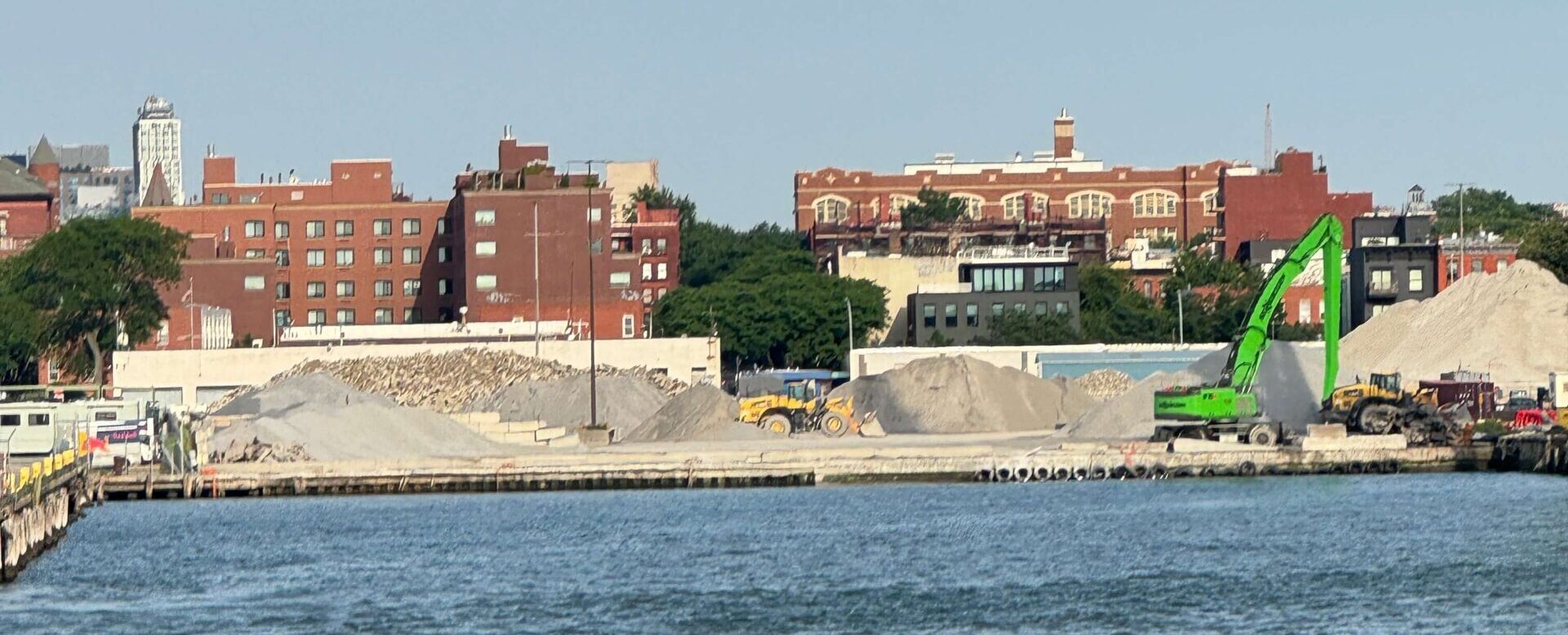A concrete recycling plant opened up along the Columbia Street waterfront earlier this year, raising concerns among some residents in the neighborhood and nearby Cobble Hill.
The plant, located by the intersection of Columbia and Kane Streets, is only there temporarily, however. It was moved there in February to accommodate the city’s plans to develop offshore wind.
Just next door to the previous recycling plant is the South Brooklyn Marine Terminal, which will be upgraded and then serve as the primary port for the entire offshore wind project.
Now, community members are worried about the growing pile of crushed concrete sitting uncovered out in the open, where it can be subject to strong winds and rainfall. Concrete contains the chemical compound crystalline silica, one of the most common materials in the earth’s crust.
When stable, it’s harmless, but if it’s disturbed, silica dust can be released into the air. Breathing in crystalline silica increases the risk of several diseases, including lung cancer, kidney disease and Chronic Obstructive Pulmonary Disease. It can also cause scar tissue to form in the lungs, making breathing more difficult. This is called Silicosis, which is incurable and can be fatal. Health issues related to silica dust are most common among construction workers and in other professions where rock or other inorganic natural materials are processed.
Not to worry
But fears of exposure to the harmful particles may be overblown. According to the city’s Department of Transportation, water is used to reduce dust during the recycling process. The pile is also sprayed regularly with water to keep the dust settled.
“DOT takes all the necessary steps to mitigate dust and keep the public safe,” a spokesperson said via email.
The DOT’s methods are standard procedure for controlling dust, explained Dr. Matthew Adams, co-director of the Materials and Structures Lab at the New Jersey Institute of Technology, who’s studied concrete extensively.
“The main dust mitigation strategy is to just spray water over the systems when you’re crushing them or moving anything. That’s how it’s done at most aggregate facilities,” he said.
Concrete recycling is a multi-step process: First, it’s broken down into chunks, after which steel and other materials that shouldn’t be there are removed. Then, the concrete is crushed multiple times until it’s reduced to pieces that range in size from a grain of sand to about an inch in diameter. This end product, called aggregate, can then be reused for various purposes.
According to Dr. Adams, dust is generally not a concern when the concrete sits in a static pile.
Another common measure is to spray the wheels of the trucks with water. This, said Dominik Slappnig, head of corporate communications and investor relations at Sika, a specialty chemicals company that makes products used in concrete recycling, prevents dust from leaving the facility, and settles on streets in the area.
The Department of Transportation does not do exactly that, but it sprays water on the roadway around the pile to prevent it from being carried away by vehicles. According to the spokesperson, an DOT environmental review showed no negative environmental impacts. However, the agency did not provide the report to the Star-Revue for review prior to publication.
But concerns about the recycling plant are not limited to dust. There are also worries that its daily operations will lead to increased traffic on Columbia Street, a thoroughfare already experiencing more congestion than usual due to the repair work on the Brooklyn-Queens Expressway.
There was also no communication to the public about the plans to temporarily relocate the recycling plant, noted Ron Barone, who lives in the area.
“They just showed up,” he said. “They didn’t give any notice, they didn’t engage community members. They just moved in their equipment, made their presence known and that was it.”
The agency spokesperson declined to comment on the record why there was no public outreach regarding the recycling plant. DOT also has not posted anything about the temporary relocation online.
“There was no outreach through our assembly person; there was no sign saying, ‘Hey, coming in two weeks, a concrete recycling facility,’” said Barone. “I would say this happened very quickly so that they wouldn’t have any stink made about it.”
According to a letter from DOT to Council Member Shahana Hanif, whose district includes the part of the waterfront where the recycling plant is now located, the agency estimates that the plant will remain there for less than two years. It will be relocated again, the DOT spokesperson wrote in an email to the Red Hook Star-Revue, once a suitable alternative site has been identified.
Author
-

I’m a New York-based journalist from Sweden. I write about the environment, how climate change impacts us humans, and how we are responding.
View all posts
I’m a New York-based journalist from Sweden. I write about the environment, how climate change impacts us humans, and how we are responding.











9 Comments
We live close to the site and the prevailing wind blows concrete dust over nearby houses. It’s so bad window sills are coated in it and we smell it in the air.
Hi Alex,
I appreciate your comment. Do you have photo/video of the dust on your window sills? I’d love to see them. Feel free to reach out to oscar@oscarfock.com if you want to chat more.
I’ve been watching this site from my rooftop since it opened. They do not keep it well watered, as stated. There IS dust and I have videos and pictures that show this. Two years is a long time to be breathing this stuff in.
This is horrible. Thank you for covering this. Many of the neighbors have been complaining about this concrete recycling facility, that seemed to have just popped up without any community input, or even notification. We are in the process of organizing a group to make sure that the community has input into whatever the city is planning for our waterfront, now that the city has taken over it. Please keep in mind that this is the city’s biggest land deal in over two decades, over 122 acres! And the piers here on the Columbia St Waterfront (Piers 8, 9a, 9b) would be the most desirable to developers because of its close proximity to Manhattan and because it is ready to be built on immediately. We just want to make sure that our community has input into what happens to this land, unlike what happened with this concrete recycling facility. Anyone that would like to join us please email ColumbiaStWaterfront@gmail.com so we can include you in upcoming announcements or meetings. Let’s make sure our community is represented in any development plans!
Hi NM,
That’s really interesting to hear. Would you be able to share those videos/photos with me? You can email them to oscar@oscarfock.com.
Thanks,
Oscar Fock
The concrete recycling facility is in very close proximity to homes, I want to highlight some issues that deserve our shared focus to ensure the community’s well-being. It seems more appropriate for the recycling facility to be further away from residential areas. I’m hoping that its current location is not permanent, and I’m prepared to consider every possible solution to advocate for its relocation if needed.
Noise Pollution: The cacophony of sound emanating from the concrete grinding machinery, the heavy thuds of concrete being dropped, the incessant hum of conveyor belts, the beeping of trucks, and the rumble of large vacuum trucks has become a constant annoyance. As a result, residents, including myself, find it imperative to keep our windows tightly closed. Unfortunately, even with the windows closed, the disruptive noise persists
Environmental Concerns: We have observed a noticeable increase in dust accumulation on vehicles and buildings, which is raising concerns about the cleanliness and aesthetics of our area. There is a 30-foot tall by 100-foot DIA pile of finely ground concrete that the wind is carrying. It is unacceptable for this pile to be facing a residential area. Despite having Dust Mitigation Planning measures in place to reduce dust emissions, the constant grinding of concrete and giant pile concrete remains too close to residential buildings to be effective.
Traffic Flow:The frequent movement of trucks and machinery has significantly impacted traffic flow, resulting in delays and safety concerns. The entrance is not large enough to safely accommodate large 18-wheelers and dump trucks block traffic when maneuvering to leave or enter. I find it puzzling that the Department of Transportation (DOT) considers this location acceptable for such a large operation. Large trucks are idling, cars are honking, and emergency vehicles are occasionally delayed due to the traffic.
Brooklyn Greenway Concerns:The safety of individuals using the Brooklyn Greenway has raised concerns, especially during busy hours when the weather is pleasant and hundreds of bikers utilize the greenway. I have observed on multiple occasions that trucks blocking the greenway and some are failing to yield to pedestrians. It is only a matter of time before something bad happens.
Zoning Observations: I want to point out that M2-1 districts do allow limited manufacturing and some commercial uses. While they allow more dustrial activities, noise, vibration, and smoke than residential zones, I want point that there is one EXCEPTION, when M2-1 use borders on a residential district, which is where the concrete recycling plant is located and I think are violating zoning laws
Community Development: It’s important to point out that there was a pledge made by the DOT over ten years ago to create a park in partnership with the Brooklyn Greenway Initiative, situated where the recycling facility now stands. This commitment was instrumental in inspiring many local entrepreneurs to invest in our neighborhood. While the present circumstances represent a shift from the original plan, we, as long-standing members of this community, are hopeful for a resolution that aligns with our shared aspirations for a park.
I totally agree with everything you said. Last week our City Council Member, Shahana Hanif, toured the facility. I saw the pictures on social media and on that day everything was wet, which according to them it’s to help stop the spreading of the dust, which may be toxic. I pointed out to her that’s not the case on a daily basis and even forwarded a picture I took in March which clearly shows how dry everything was that day. I’d love to discuss this further with you, or anyone else, who’s interested in advocating for the relocation of this concrete recycling plant. Let’s ensure that this doesn’t happen again and that going forward the city takes into account our community in the upcoming redevelopment of our waterfront. Please email me at Mr.JohnLeyva@gmail.com or ColumbiaStWaterfront@gmail.com so we coordinate our efforts. Thank you.
“Dust is generally not a concern when the concrete sits in a static pile.”
Except it doesn’t sit in static piles. It’s dumped from trucks, then moved around from place to place in the site, causing clouds of dust that anyone overlooking the site can see. And if you do NOT want silica dust in your lungs, or your kids’ lungs.
The dust control measures are intended to protect the worksite during operations but fail to prevent dust from drying and blowing into our windows during off hours. Since operations began, our windows and cars have become significantly dirtier, and every neighbor has complained about it.
The noise pollution might be even worse than the air pollution. They start at around 6 AM every day, with the sounds of beeping trucks, concrete grading machines, dust control vacuum trucks, and DOT trucks honking. It’s impossible to keep the windows open.
Two years in DOT years is more like ten years. I don’t trust their timeline, and it’s been terrible since they started. I would love to know if there’s any legal way to get them to move as soon as possible.